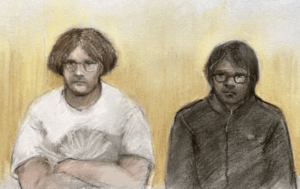
A recent courtroom sketch captures two 19-year-old defendants accused of playing central roles in the “Scattered Spider” cybercrime group, allegedly responsible for $115 million in ransoms. Against a bleak yellow background, the young men sit with downcast expressions, their posture reinforcing the gravity of the charges. It raises an important question: are we simply witnessing a trial, or also the artist’s interpretation of guilt?
Courtroom sketchers are tasked with documenting proceedings when cameras are banned, yet their work is far from neutral. Every decision pose, angle, or expression can shape how the public perceives the accused. In this sketch, the defendants appear diminished, almost fragile, while their alleged crimes loom large. Such portrayals risk influencing not just audiences following the case, but the atmosphere in the courtroom itself.
This creates a paradox. In an environment built on impartiality, sketch artists act as interpreters, not just reporters. Their drawings blur the line between record and commentary, leaving them with a surprising amount of power in shaping narratives of justice. In effect, they function as an unofficial “extra juror,” guiding how the story of a trial is remembered before the verdict is even reached. What do you think about courtroom sketching? Inherently interpretive?
